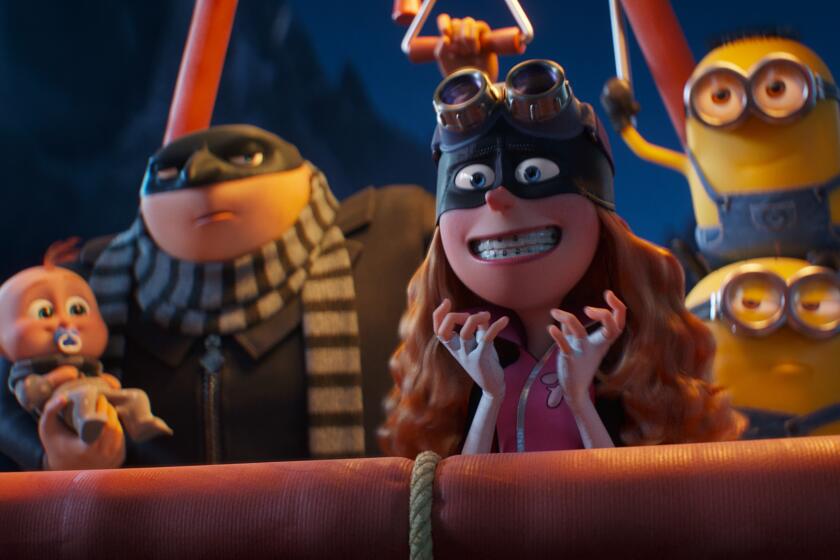Larry Buchanan, 81; Directed Classics of Bad Moviemaking
Larry Buchanan, the self-declared “schlockmeister” who created such critically panned but highly successful television movies as “Mars Needs Women,” “Curse of the Swamp Creature” and “Zontar, the Thing From Venus,” has died. He was 81.
Buchanan, who also created conspiracy docudramas and quirky biopics, died Dec. 2 in Tucson of complications from a collapsed lung.
He made roughly 30 pictures over four decades, horrifying critics, delighting fans and gratifying financial backers with his one-man, self-described “guerrilla filmmaking.” He wrote, directed, produced and edited most of his films, and even photographed and acted in a few.
Many of Buchanan’s titles landed on “worst movies” compilations, but they all recouped their modest production costs and most made a handy profit. Known more for frugality than for quality, Buchanan completed one of his earliest films, “Grubstake” (also titled “Apache Gold”), in 1952 for $17,000, and was still making movies for well under $1 million into the late 1980s.
One of the filmmaker’s most durable productions was “Mars Needs Women” in 1967, starring Tommy Kirk and Yvonne Craig. The sci-fi plot calls for Kirk and a few of his Martian friends to invade Earth in search of nubile women, with the goal of increasing the birthrate on the red planet.
“Strangely sincere but extremely silly and distended,” Leonard Maltin described the chestnut in his 2004 Movie and Video Guide. “Most important revelation: Mars abandoned neckties 50 years ago.”
One of the first makers of feature films specifically for television, Buchanan was philosophical about his reputation, titling his 1996 autobiography: “It Came From Hunger! Tales of a Cinema Schlockmeister.”
“I suspect I might first have been recognized for the wrong reasons,” he told the Fort Worth Star-Telegram in 1997. “It kind of stung, at first, to be singled out as a maker of movies that are considered ‘so bad they’re good,’ but then you’ve got to realize the only bad recognition is no recognition.”
Born Marcus Larry Seale Jr. in Mexia, Texas, and orphaned in infancy, Buchanan grew up in a Dallas orphans’ home, where he developed a love of movies in the facility’s theater.
He considered becoming a minister, but during a visit to Hollywood landed a job in 20th Century Fox’s prop department. The studio gave him a new name along with minor acting roles.
Buchanan joined the Army Signal Corps working on films during World War II, then worked briefly in East Coast television before returning to Texas to set himself up as an independent filmmaker.
After he made one of the first blaxploitation films, in 1963, “Free, White and 21,” which proved highly lucrative, Buchanan was asked by American International Pictures to deliver more “cheap, fast color pictures.” He complied, providing another dozen and a half for the company’s direct-to-television and overseas distribution.
Along with his horror-tinged sci-fi offerings -- “The Eye Creatures,” “In the Year 2889,” “It’s Alive!” -- Buchanan cooked up his own conspiracy theory docudramas, such as “The Trial of Lee Harvey Oswald” in 1964 and “Down on Us” in 1984, which claimed the government was behind the deaths of entertainers Jimi Hendrix, Jim Morrison and Janis Joplin.
He also delved into biopics, displaying his own skewed takes on such celebrities as “Pretty Boy” Floyd, Howard Hughes and, especially, Marilyn Monroe. Buchanan cast Fabian as Floyd in his 1970 “A Bullet for Pretty Boy,” and particularly prided himself on the film’s machine-gun scenes. He offered his impression of the aviator in his 1977 “Hughes and Harlow: Angels in Hell.”
Clearly fascinated with Monroe, Buchanan claimed to have met her in 1946 and introduced her to a bodyguard nicknamed Mesquite. The eclectic director eventually made two films about the blond actress: “Goodbye, Norma Jean” in 1976, describing Monroe’s teen years, and “Goodnight, Sweet Marilyn” in 1989.
The second film spelled out Buchanan’s own theory of what happened on Aug. 5, 1962, when Monroe was found dead in her Bel-Air home of an apparently suicidal drug-and-alcohol overdose.
“We got an awful lot of lies from the powers-that-be in Los Angeles, down in City Hall and from the coroner’s office,” Buchanan told The Times in 1990. “We got a lot of garbage from all of them, so we came forward with a very simple truth.”
The “truth” was that Mesquite, carrying out an agreement with Monroe, gave her a lethal dose of drugs to help her “to the other side,” rescuing the actress from inevitable institutionalization. “She knew she was going very fast neurologically, and that insanity ran on both sides of the family,” Buchanan told Newsday when the film was completed, “and she dreaded being put in an institution like her mother. They made a pact that if her mind went ... he would help her to the other side.”
Buchanan, who is survived by his wife, Jane, and four children, had recently completed post-production work on a film he made about 30 years ago: “The Copper Scroll of Mary Magdalene,” about the historical Jesus.
“I don’t know that I bring any great command of the art to my pictures,” Buchanan said in 1997, “but I love what I’m doing, and I believe that shows through in the least of my pictures. We certainly weren’t trying to make anybody laugh. We meant to entertain, perhaps to provoke, to enlighten -- and certainly to defy the customary formulas.”
More to Read
Only good movies
Get the Indie Focus newsletter, Mark Olsen's weekly guide to the world of cinema.
You may occasionally receive promotional content from the Los Angeles Times.






